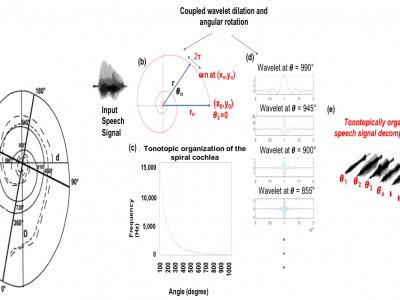Documents
Poster
Cochlear Decomposition: A Novel Bio-inspired Multiscale Analysis Framework

- DOI:
- 10.60864/05sr-b197
- Citation Author(s):
- Submitted by:
- Hessa Alfalahi
- Last updated:
- 17 November 2023 - 12:07pm
- Document Type:
- Poster
- Document Year:
- 2023
- Event:
- Presenters:
- Hessa Alfalahi
- Paper Code:
- 4835
- Categories:
- Log in to post comments
Signal multiscale decomposition (SMD) is an effective analysis for
the identification of modal information in time-domain signals. So
far, various SMD approaches, such as the Multiresolution Wavelet
Transform (MWT), the Empirical Mode Decomposition (EMD), and
the Variational Mode Decomosition (VMD) have been proposed,
However, issues, such as mode mixing for signals with closelyspaced
modes, have been identified. To confront such problems, we
propose here a novel spatial auditory decomposition framework for
non-stationary signals, namely the cochlear decomposition (CD).
CD is inspired by the biological rules of the spiral human cochlea
and it is built upon the concept of ‘place-pitch’ or the tonotopic organization
of the spiral cochlea. The new insight here is to formulate
a set of basis functions, namely cochlear wavelets, whose dilation
factors are determined by their angular position on the cochlear
spiral (i.e., coupled rotation and dilation). Under proper parameterization,
iterative application of spatial filters eventually results
in signal’s mono-components, each arising from specific angular
positions along the spiral cochlea, with high time and frequency
localization. The performance of the proposed CD is validated via
synthetic acoustic signals and real non-stationary speech signals
analysis. The analysis results show that CD outperforms the performance
of MWT, EMD, and VMD, exhibiting, at the same time,
high noise robustness. We also show that the CD disentangles lowfrequency
temporal modulations of sounds, supporting perceptual
phenomena in both speech and music. Clearly, CD paves the way
for higher-level speech perception deep learning models and also
for efficient cochlear implants design. Future work to incorporate
the nonlinearity of the cochlea into a binaural hearing framework is
underway.

